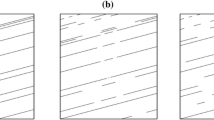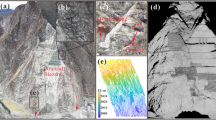Abstract
Ground control failures are one of the main causes of accidents in the underground stone mining industry. Some of the fundamental tools for rockfall hazard identification are related to rock mass characterization and geotechnical discontinuity mapping. Recent technological advances in these methods are related to remote sensing techniques and point cloud processing software for automated discontinuity mapping. Remote sensing techniques, such as LiDAR and photogrammetry, generate multi-million point clouds with millimetric precision, capturing the structure of the rock mass. The automated point cloud processing tools offer alternative algorithm-based methods to characterize and map these discontinuities. However, their applicability is constrained by multiple factors such as site specific conditions of the rock mass and the parameters used within the mapping algorithms. This paper evaluates the performance of automated discontinuity extraction software compared with manual virtual discontinuity mapping. Sampling windows from laser-scanned sections in an underground limestone mine are defined and mapped using discontinuity set extractor (DSE). Results from the virtual discontinuity software are compared with manually extracted fractures from I-Site based on reviewing orientation, trace length, spacing, number of extracted discontinuities, and processing time. The analysis determined that the automated mapping algorithm was able to identify the same discontinuity sets that had been manually mapped. The automated mapping software mapped an excessive amount of smaller fractures, which caused the comparison of both mapping techniques to be unsuccessful in terms of trace length and spacing.










Similar content being viewed by others
References
MSHA (2020) "Accident Injuries Data Set," Mine Safety and Health Administration
Esterhuizen GS, Dolinar DR, Ellenberger JL, Prosser LJ (2011) Pillar and Roof Span Design Guidelines for Underground Stone Mines. National Institute for Occupational Safety and Health, Pittsburg
Brown E (2012) Risk assessment and management in underground rock engineering - an overview. J Rock Mech Geotech Eng 4:193–204
Joughin W, Muaka J, Mpunzi P, Sewnun D, Wesseloo J (2016) "A risk-based approach to ground support design," in Ground Support 2016, Lulea
Barton N (1978) Suggested methods for the quantitative description of discontinuities in rock masses. Int J Rock Mech Min Sci Geomech 15(6):319–368
Chao J, Yong L, Mingyuan L, Xiaoyong Z (2017) Jointed surrounding rock mass stability analysis on an underground cavern in a hydropower station based on the extended key block theory. Energies 10(4):563
Monsalve J, Baggett J, Soni A, Ripepi N, Hazzard J (2019) Stability analysis of an underground limestone mine using terrestrial laser scanning with stochastic discrete element modeling. 53rd US Rock Mechanics/Geomechanics ARMA Symposium, New York
Grenon M, Landry A, Hadjigeorgiou, Lajoie, P (2017) Discrete fracture network based drift stability at the Éléonore Mine. Mining Technol 126(1):22–33
Fu G, Ma G, Qu X, Huang D (2016) Stochastic analysis of progressive failure of fractured rock masses containing non-persistent joint sets using key block analysis. Tunn Undergr Space Technol 51:258–269
Jing L, Stephansson O (2007) Discrete Fracture Network (DFN) Method. In: Fundamentals of Discrete Element Methods for Rock Engineering Theory and Applications. ELSEVIER, Amsterdam, pp 365–398
Voyay I, Roncella R, Forlani G, Ferrero A (2006) Advanced techniques for geo structural surveys in modelling fractured rock masses: application to two Alpine sites. Laser Photogramm Methods Rock Face Charact:102–108
Cacciari P, Futai M (2015) "Mapping and characterization of rock discontinuities in a tunnel using 3D terrestrial laser scanning," Bull Eng Geol Environ
Rogers S, Bewick R, Brzovic A, Gaudreau D (2017) "Integrating photogrametry and discrete fracture network modelling for improved conditional simulation of underground wedge stability," 8th International Conference in Deep and High Stress Mining, pp. 599-610
Riquelme A, Abellan A, Tomás R, Jaboyedoff M (2014) A new approach for semi-automatic rock mass joints recognition. Comput Geosci 68:38–52
Dewez T, Girardeau-Montaut D, Allainc C, Rohmer J (2016) "FACETS: A Cloud Compare plugin to extract geological planes from unstructured 3D point clouds," in Int. Arch. Photogramm. Remote Sens. Spatial Inf. Sci., Prage
Kemeny J, Donovan J (2005) "Rock mass characterisation using LiDAR and automated point cloud processing," Min Geol Eng 38(11):26–29
Zhang P, Li J, Yang X, Zhu H (2018) Semi-automatic extraction of rock discontinuities from point clouds using the ISODATA clustering algorithm and deviation from mean elevation. Int J Rock Mech Min Sci 110:76–87
Zhang P, Du K, Tannant D, Zhu H, Zheng W (2018) Automated method for extracting and analysing the rock discontinuities from point clouds based on digital surface model of rock mass. Eng Geol 239:109–118
Guo J, Liu Y, Wu L, Liu S, Yang T, Zhu W, Zhang Z (2019) A geometry- and tecture-based automatic discontinuity trace extraction method for rock mass point cloud. Int J Rock Mech Min Sci 124(104132):1–10
Monsalve J, Baggett J, Bishop R, Ripepi N (2019) Application of Laser Scanning for Rock Mass Characterization and Discrete Fracture Network Generation in an Underground Limestone Mine. Int J Min Sci Technol 29:131–137
Esposito G, Mastrorocco G, Salvini R, Oliveti M, Starita P (2017) "Application of UAV photogrammetry for the multi-temporal estimation of surface extent and volumetric excavation in the Sa Pigada Bianca open-pit mine, Sardinia, Italy," Environ Earth Sci volume 76
Slaker B (2015) Monitoring underground mine displacement using photogrammetry and laser scanning. Virginia Tech, Blacksburg
Gabara G, Sawicki P (2017) A new approach for inspection of selected geometric parameters of a railway track using image-based point clouds. Sensors 18(3):791
Rocscience, "Rocsicence," 26 August 2019. [Online]. Available: https://www.rocscience.com/help/dips/#t=dips%2FGetting_Started.htm. Accessed 26 August 2019
Vose D (2008) Risk analysis: a quantitative guide. John Wiley & Sons
Emery J, Canbulat I, Zhang C (2020) Fundamentals of modern ground control management in Australian underground coal mines. Int J Min Sci Technol 30:573–582
Hawley M, Marisett S, Beale G, Stacey P (2009) Performance assessment and monitoring. In: Guidelines for Open Pit Slope Design. CSIRO, Collingwood, pp 327–380
Department of Mines, Industry Regulation and Safety, "Ground control management in Western Australian mining operations - guideline," Department of Mines Industry Regulations and Safety, Western Australia, 2019
Monsalve J, Soni A, Rodriguez-Marek A, Ripepi N (2020) "A preliminary investigation on stochastic discrete element modeling for pillar strength determination in underground limestone mines from a probabilistic risk analysis approach," in 39th International Conference on Ground Control in Mining
Acknowledgements
The authors would like to thank Lhoist mining engineers and management for their support and guidance during this project. MAPTEK is acknowledged for providing a license of the software I-Site Studio.
Funding
This work is funded by the NIOSH Mining Program under Contract No. 200-2016-91300. Views expressed here are those of the authors and do not necessarily represent those of any funding source.
Author information
Authors and Affiliations
Corresponding author
Ethics declarations
Conflict of Interest
The authors declare that they have no conflict of interest.
Additional information
Publisher’s Note
Springer Nature remains neutral with regard to jurisdictional claims in published maps and institutional affiliations.
Rights and permissions
About this article
Cite this article
Monsalve, J.J., Pfreundschuh, A., Soni, A. et al. Automated Discontinuity Extraction Software Versus Manual Virtual Discontinuity Mapping: Performance Evaluation in Rock Mass Characterization and Rockfall Hazard Identification. Mining, Metallurgy & Exploration 38, 1383–1394 (2021). https://doi.org/10.1007/s42461-021-00416-9
Received:
Accepted:
Published:
Issue Date:
DOI: https://doi.org/10.1007/s42461-021-00416-9




